A○○hole [Research]
This week, from Monday through Friday, we have big conference (Ocean Science Meeting) co-organized by ASLO(American Society of Limnology and Oceanography)、TOS (The Oceanography Society) and AGU(American Geophysical Union)at Hawaii Convention Center in Honolulu. Last time when I joined this meeting, I came here from Tokyo spending 8 hours and 800 bucks, and was bothered by jet lag through the periods. But now I live in Honolulu, just 5 minutes by bike from the center. What a exciting change I had!
By the way, we pronounce “S” of ASLO using voiced consonant, like as “azlo”. Nick and Ryan advised me not to pronounce it as “aslo”. Otherwise, it might sound like another word. Take care.
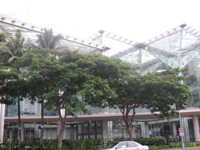
(Hawaii Convention Center)
Good Bye, Maui [Research]
I’ve been back to my sweet home! It’s very comfy, but I feel loneliness after the life sharing condo with friends. I’m going to put some photos taken at Maui, though no photo on our study is available. Usually we were too busy to take photos during working.

Went to the garage of Aloha Airline to pick up our research equipments. Cargo fee including insurance is about $500 for 2 pallets.
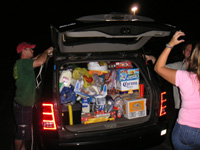
We shared 1 condo with two bed rooms, and then bought foods and drinks (beers) for 1 week stay. The trunk was totally filled with research equipments and foods.

Our battlefront, tent. This space was used mainly for processing collected seawater and taking a nap during the samplings. Main members of this trip, Iuri, Becky, Chris and Megan.
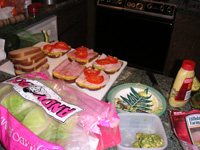
Lunch was usually sandwich. Becky & Megan usually fabricated special one for each, because we are particular for food; no mayo, a lot of mustard, chicken only, no tomato and so on. Thank you for memorizing my favorites-.
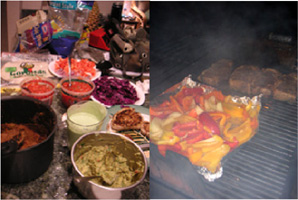
Someone took charge of cooking dinner. I’ve got to make dinner, Japanese food or something, next time. Jennifer’s making tortilla & salsa(left)、Steaks with Heather’s special taste (right)
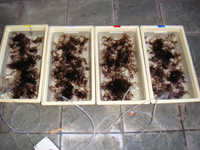
Pre-incubation of representative harmful algae, “Hypnea musciformis” for later in situ incubation in the field.

Chris, who had lived in Maui for 3 years, took me and Megan to his recommended restaurant, “Fish Market Restaurant” at Paia. The fish burger was awesome! I feel hungry just by looking this photo. If I’d had time, I could have joined his tour to Ahihi-Kina’u. Next time!
What’s this? [Research]
As for previously purchased PVC board (http://blog.so-net.ne.jp/hawaiian_life_e/archive/20051221), I could not find any factory who agree to fabricate racetrack flume from the plan in economic price. So I fabricated it by myself for my study spending a little bit boring time during Happy Holidays. This is not sophisticated one, because available tools were just plastic cutter, drill, rivet gun, epoxy cement and silicone. It took longer time than expected to finish, because it’s still difficult to for me find the place where I can get what I actually needed. Now my office was filled with chemical smells due to these cements. I tried to offset these smells by Asian incense, but it turned into another weird smells…. Tomorrow, I’ll probably try to fill water inside. I’m scared that water is leaking out… How it turned out?
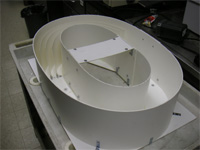
Racetrack flume [Research]
Though I want racetrack flume for incubation experiments, our department does not have machine factory, and we don’t have any technician who are familiar with fabricating such an aquarium. I had nothing to do without going to a factory ”Hawaii Plastics Corp.” by myself.
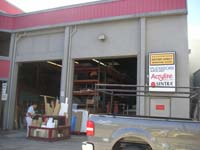
At first they rejected my plan, and sent me another factory, “Min’s Plastic”, who said also “We could not make it”. But after negotiating with the chief manager of ”Hawaii Plastics Corp.”, I managed to ask them to fabricate just parts. I need to glue them later, devising the method which prevent any leaking.
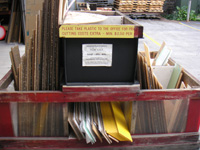
This factory also sells the rag of plastic board with 40% to 60% discounted price. That should be nice for fabricating toys or something like that.
Lesson week [Research]
My scientific background is “geography and marine biogeochemistry”. One of objectives to come to “botany department” was to reinforce the sense and technique of biology. So far, however, I was not so eager in learning new biological techniques here, due to busyness of laborious paper works and routine field works. Then, I changed to my mind, and prepared other proposal of my study, reading many papers mainly on physiology of terrestrial and marine plants.
Therefore, I set this week and subsequent few weeks as “special lesson weeks” to learn some biological techniques. The keyword of this week is “fluorescence”. I’m learning basic techniques about how to use fluorescence microscope and PAM fluorometer from Celia and Meg. They would be useful for my study to know anatomical characteristics of macroalgae and their photosynthetic performance. Learning new techniques and scientific contents in English is so difficult. Thank you for your patience for my poor understanding, Celia and Meg. I’ll need many trials by myself, seeing papers and text books. But such techniques will inspire me with new ideas for my study. I’m so excited.
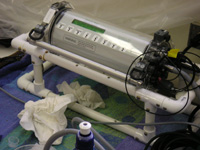
PAM(pulse amplitude modulation) fluorometer
Potluck Lunch & Seminar [Research]
Dr. L. McCook, who is prominent ecologist mainly at Coral Reef Ecosystem, visited our laboratory. He has worked around GBR (Great Barrier Reef) for this decade based on AIMS(Australian Institute of Marine Science). Then, we had potluck lunch with him serving Korean BBQ. His group has focused on coral-seaweed interaction and their importance in reef degradation and resilience. His organized session at 9th ICRS (International Coral Reef Symposium) in 2000 was so exiting one, because it was first conference just after the world-wide coral bleaching in 1998. Though I’ve introduced myself to him before, I’m sorry that my study was not so impressive for him. Umm. At the next day, he presented about current his research and management for the protection of the GBR. Not only the contents, the skill of presentation was also useful for me.
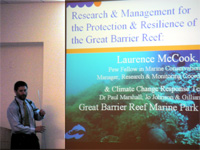
Research Vessel “Hakuho-Maru” [Research]
I visited Japanese research vessel, “Hakuho-Maru” which stops at Honolulu Port during these 4 days.
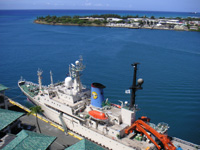
At first, I planed to welcome them wearing Hawaiian hula costume and purchased it. But, the place, where she was anchored, was beside Aloha Tower and luxurious restaurants. There were many tourists. Then I gave up wearing such a costume… Umm, when and where can I use this costume?
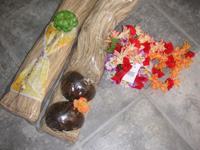
Waikiki Aquarium [Research]
I was interested in measuring temporal variation of DIN concentrations and their nitrogen stable isotope signatures in pumped-up well water and effluent water at Waikiki Aquarium. Those data will give us information about primary diagenesis in coral reef sediments and nitrogen dynamics in coral reef ecosystem. Then I asked Zac, who is PD researcher at Zoology Dept., to guide Aquarium and introduce me to responsible persons. Thanks to his supports, I finally could have time to talk with “director” Andy, “curator” Jerry and other workers Charles and Mike.
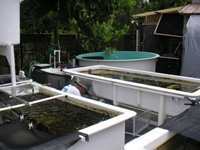
Zac’s experiment tanks in backyard
(Click following blue colored Japanese phrase, to jump next page)
3rd version [Research]
So far, I had many chances to deploy data logger, such as current meter, nephelometer, and temperature meter and so on, in the sea at Okinawa, Palau and Thailand. 1st version used in Okinawa was assembled by iron tube and clamp, then so heavy and big one. In Thailand, local steel metal worker made us sophisticated pyramid-shaped frame in economic price. Probably that frame might have been flown away somewhere in the Tsunami attack last December. Then this year, I gave birth to 3rd version frame in Hawaii! I fabricated it using frame of chair, which was selected in Wal Mart. This guy is pretty good. This has compact size but stable shape and somewhat heavy weight, which can stand against strong current at the sea bottom. And it is mobile frame. I can easily convey it by bike. It’s highly improved compared with 1st version!
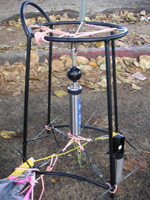
Certification [Research]
In UH, there are many safety programs related to usual field studies and experiments(http://www.hawaii.edu/ehso/). In fact, I’m interested in “Diving Safety”, but it’s not urgent one. I took “Biological Safety Program”(http://www.hawaii.edu/ehso/bio/) for my future study. The students and faculties, who use bacteria in their studies, must finish this program.
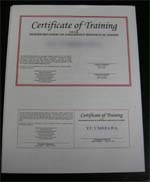
Also at the universities in Japan, such a safety programs is getting used to be held in these years, because national university changed to corporate body a couple of years ago. But it seems that the care and consciousness for the bioterrorism has not been still equipped enough, in Japan. As for diving safety, although the Japanese Coral Reef Society (JCRS)(http://wwwsoc.nii.ac.jp/jcrs/english/index.html), in which many researchers using diving affiliates, equip such a committee, the rules may not be kept by the members.



